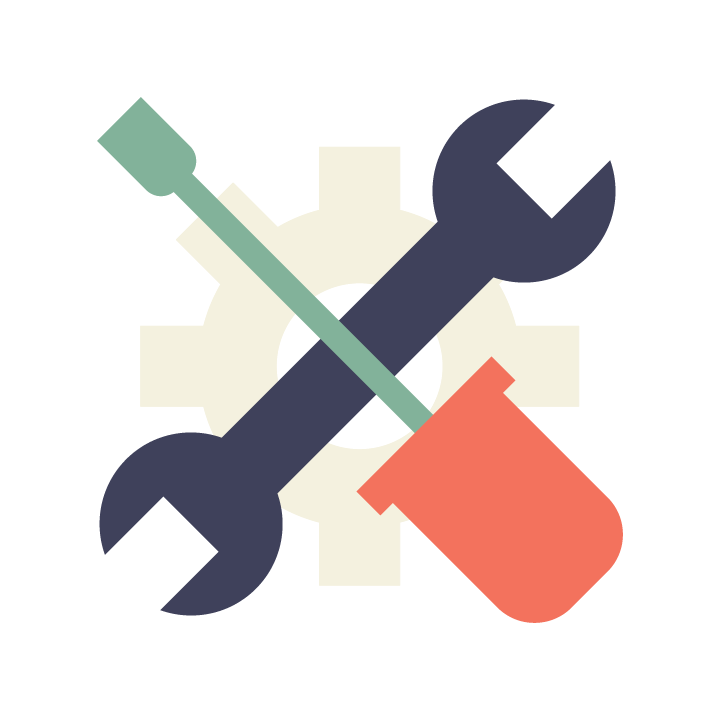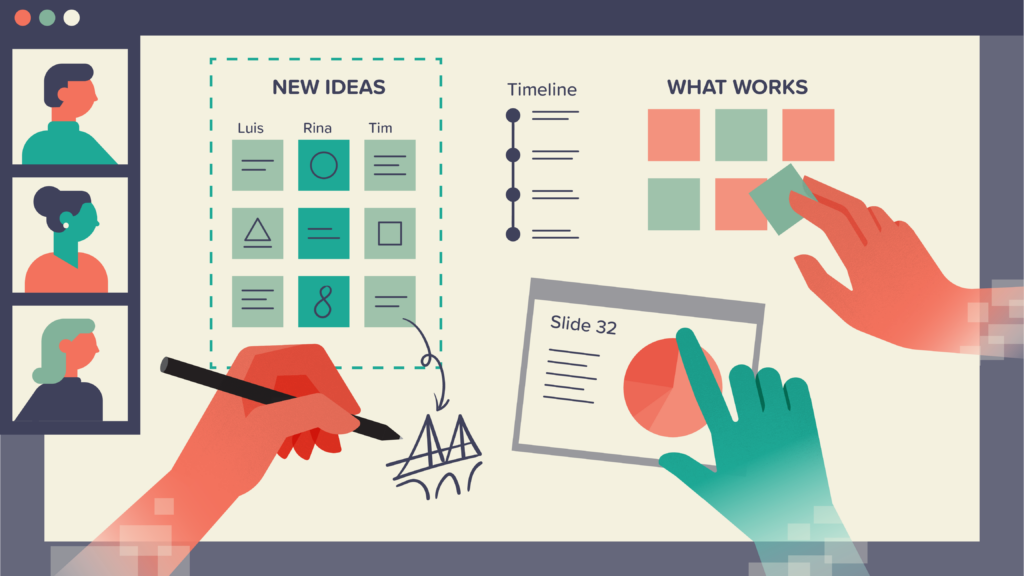This is part of a series about virtual collaboration in the age of COVID. Illustrations by Christina Wang & Ted May / Tremendousness.
5 must-haves for effective and engaging virtual collaboration
For many knowledge workers, this is a brave new world. Despite the fact that we usually sit in front of computers most of the day, and always have, we’re not used to doing everything in front of computers every day.
We can email and Slack and talk on the phone just fine, just like before. But we can’t get together—we can’t brainstorm at a whiteboard and we can’t talk or physically collaborate in active groups like we used to.
We are now virtual workers, doing everything through a screen and on a wire. Many are out of a job during this pandemic, but our work can get done.
But there are two sides to the world of virtual work. Confoundingly, it is: 1. Incredibly advanced, and 2. Incredibly primitive.
We have live video calls… that glitch out.
We have onscreen drawing tools… that feel like decades-old technology.
We have rich collaborative workspaces… that people simply get lost in.
But! Our work can get done! The tactics and tools exist. What most people need is guidance and experience. So here’s a little bit of what we’ve learned doing virtual collaboration.
These five things are must-haves:
A facilitator with a plan
 If you need to get something important done you probably need a plan. And if it’s important enough for a meeting it probably needs an agenda. An agenda gives complex collaboration sessions—especially in fast-moving times of crisis—the structure you need to get things done. Because everyone’s distributed, it’s best to err on the side of over-communication.
If you need to get something important done you probably need a plan. And if it’s important enough for a meeting it probably needs an agenda. An agenda gives complex collaboration sessions—especially in fast-moving times of crisis—the structure you need to get things done. Because everyone’s distributed, it’s best to err on the side of over-communication.
Just getting everyone on a big call is a recipe for chaos and frustration. The solution: a skilled facilitator can design a sequence of guided exercises to surface the important info and insights you need. And these exercises can be customized to specific online tools or technological limitations. Best of all, the group activities can be visible to all participants and the workspace can live on (and be shared) as an artifact.
An app with collaborative tools
 Whether Zoom or Webex or Miro or another solution, you need a way to actually collaborate, to guide the process and capture ideas—a rich experience that isn’t just a glorified video chat. Different apps have different strengths. All have a learning curve. The trick is to be informed and selective about which solution you use in a given situation. Don’t try to stack too many tools on top of one another.
Whether Zoom or Webex or Miro or another solution, you need a way to actually collaborate, to guide the process and capture ideas—a rich experience that isn’t just a glorified video chat. Different apps have different strengths. All have a learning curve. The trick is to be informed and selective about which solution you use in a given situation. Don’t try to stack too many tools on top of one another.
Zoom is great for virtual meetings, especially for screen sharing our live sketching. And now it even lets you create “breakout” rooms so smaller groups of people can go off work on their own in the same call, then get back together with the large group. Miro is an entire world of virtual collaboration, enabling group activities that involve drawing, sketching, digital sticky notes, discussion, voting, and more. But be careful about overloading the team with too many different tools.
A connection you can rely on
 Every “how to work remotely” blog post these days recommends turning your camera on (after you’ve read some other blog post about how to look good on camera) and we generally agree with this. It creates connection. But we only agree with this caveat: sometimes it’s worth it for everyone to turn off video so that bandwidth can be used on the tool itself. Human connection’s no help if it breaks your network connection.
Every “how to work remotely” blog post these days recommends turning your camera on (after you’ve read some other blog post about how to look good on camera) and we generally agree with this. It creates connection. But we only agree with this caveat: sometimes it’s worth it for everyone to turn off video so that bandwidth can be used on the tool itself. Human connection’s no help if it breaks your network connection.
It’s frustrating for everyone when audio drops, video freezes, the onscreen activities aren’t refreshing, or your internet connection dies entirely. And while the hack of dialing in on your phone means you won’t lose the thread of conversation, it’s still frustrating to play catch up onscreen. So when your kids are streaming Netflix or your roommates are playing video games and your meeting is going to glitch hell, don’t feel bad about asking everyone to please turn off their video feed. Of course, you may need to boost your internet plan.
A tech expert in the background
 People will inevitably struggle with new tools (especially right now!), or need some kind of tech or process support. Even if you’ve given a tutorial at the start, it’s smart to have a knowledgeable team member on the call (or on call)—someone completely dedicated to helping individuals with tech issues so the larger group can keep working.
People will inevitably struggle with new tools (especially right now!), or need some kind of tech or process support. Even if you’ve given a tutorial at the start, it’s smart to have a knowledgeable team member on the call (or on call)—someone completely dedicated to helping individuals with tech issues so the larger group can keep working.
From our perspective—and the client’s—if a Tremendousness facilitator or sketch artist has to stop the call to help troubleshoot someone’s microphone problems, or teach people how to edit a digital sticky note (for the fifth time), everyone loses. So make sure an expert can help attendees one-on-one through a backchannel so the collaboration can continue for everyone else.
And finally… a live sketcher front & center!
 The secret sauce! Bringing ideas to life through rapidly iterated drawings is what really moves the marker (in more ways than one!) for our clients. I’ve said it before and I’ll say it again: live sketching helps make ideas real, turning a “what if…” into a “that’s it!”.
The secret sauce! Bringing ideas to life through rapidly iterated drawings is what really moves the marker (in more ways than one!) for our clients. I’ve said it before and I’ll say it again: live sketching helps make ideas real, turning a “what if…” into a “that’s it!”.
You may not have a team member comfortable doing this, but we’ve got lots. Not only does it increase the productivity of the group, it also improves the general vibe of the virtual meeting. Something is happening. Things are being created. Words are coming to life.
Work is getting done, even in these strange and trying times.
